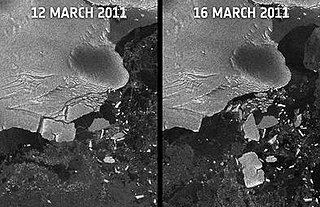The Slessor Glacier is a glacier at least 140 km long and 90 km wide, flowing west into the Filchner Ice Shelf to the north of the Shackleton Range. First seen from the air and mapped by the Commonwealth Trans-Antarctic Expedition (CTAE) in 1956. Named by the CTAE for RAF Marshal Sir John Slessor, chairman of the expedition committee.
The Alexandra Mountains are a group of low, separated mountains in the north portion of Edward VII Peninsula, just southwest of Sulzberger Bay in Marie Byrd Land, Antarctica.

The Axel Heiberg Glacier in Antarctica is a valley glacier, 30 nautical miles long, descending from the high elevations of the Antarctic Plateau into the Ross Ice Shelf between the Herbert Range and Mount Don Pedro Christophersen in the Queen Maud Mountains.
The Cook Mountains is a group of mountains bounded by the Mulock and Darwin glaciers in Antarctica. They are south of the Worcester Range and north of the Darwin Mountains and the Britannia Range.

The Darwin Glacier is a large glacier in Antarctica. It flows from the polar plateau eastward between the Darwin Mountains and the Cook Mountains to the Ross Ice Shelf. The Darwin and its major tributary the Hatherton are often treated as one system, the Darwin–Hatherton.

King Edward VII Land or King Edward VII Peninsula is a large, ice-covered peninsula which forms the northwestern extremity of Marie Byrd Land in Antarctica. The peninsula projects into the Ross Sea between Sulzberger Bay and the northeast corner of the Ross Ice Shelf, and forms part of the Ross Dependency. Edward VII Peninsula is defined by the Ross Ice Shelf on the southwest, Okuma Bay on the west, and to the east by Sulzberger Bay and the Saunders Coast, all essentially on the Ross Sea / Southern Ocean in Antarctica. The northwest extremity of the peninsula is Cape Colbeck. Edward VII Peninsula is located at 77°40′S155°00′W.
Edward VIII Bay is a bay about 32 kilometres (20 mi) in extent, located between Edward VIII Plateau and the Øygarden Group of islands in Antarctica. The head of the bay is occupied by the Edward VIII Ice Shelf. The bay was discovered in 1936 by Discovery Investigations personnel on the RRS William Scoresby, and named for Edward VIII, then King of the United Kingdom.
The Edward VIII Plateau is a dome-shaped, ice-covered peninsula between Magnet Bay and Edward VIII Bay in Antarctica. It was probably seen by personnel on the RSS William Scoresby in 1936, and mapped from aerial photos taken by the Lars Christensen Expedition, 1936-37, and named Gulfplataet. It was renamed "King Edward Plateau" by ANCA, but the form Edward VIII Plateau has been approved by the Advisory Committee on Antarctic Names (US-ACAN) to be consistent with the names of nearby Edward VIII Bay and Ice Shelf.
Seaton Glacier is a glacier 17 miles (27 km) long, flowing southeast into Edward VIII Ice Shelf at the northwest part of Edward VIII Bay. It was mapped by Norwegian cartographers from aerial photos taken by the Lars Christensen Expedition, 1936–37, remapped, 1954–58, by ANARE and named by ANCA in 1958 for Flight Lt. John Seaton, RAAF, pilot with ANARE at Mawson in 1956.

Sulzberger Bay is a bay indenting the front of the Sulzberger Ice Shelf between Fisher Island and Vollmer Island, along the coast of Marie Byrd Land, Antarctica.

Okuma Bay is a bay located at 77°50'S 158°20'W on the Ross Ice Shelf of Antarctica at its juncture with Edward VII Peninsula.
The Mulock Glacier is a large, heavily crevassed glacier which flows into the Ross Ice Shelf 40 kilometers south of the Skelton Glacier in the Ross Dependency, Antarctica.
Voyeykov Ice Shelf, is an ice shelf fringing the coast between Paulding Bay and Cape Goodenough, Antarctica. Mapped by the Soviet Antarctic Expedition (SovAE) (1958) and named after Aleksandr I. Voyeykov (1842–1916), a Russian climatologist.

Posadowsky Glacier is a glacier about 9 nautical miles long, flowing north to Posadowsky Bay immediately east of Gaussberg. Posadowsky Bay is an open embayment, located just east of the West Ice Shelf and fronting on the Davis Sea in Kaiser Wilhelm II Land. Kaiser Wilhelm II Land is the part of East Antarctica lying between Cape Penck, at 87°43'E, and Cape Filchner, at 91°54'E, and is claimed by Australia as part of the Australian Antarctic Territory. Other notable geographic features in this area include Drygalski Island, located 45 mi NNE of Cape Filchner in the Davis Sea, and Mirny Station, a Russian scientific research station.
Bryan Coast is that portion of the coast of Antarctica along the south shore of the Bellingshausen Sea between Pfrogner Point and the northern tip of the Rydberg Peninsula. To the west is Eights Coast, and to the east is English Coast.
The Nash Range is a mainly ice-covered coastal range in the Churchill Mountains of Antarctica.
Cape Davis is a rounded ice-covered cape along the north coast of Edward VIII Plateau, 17 kilometres (9 nmi) east of Magnet Bay. It was discovered on 12 January 1930 by the British Australian and New Zealand Antarctic Research Expedition (BANZARE) under Mawson, who named it for Captain John King Davis, Director of Navigation under the Commonwealth Government and ship's captain and second in command of BANZARE.
Golubaya Bay is a bay in the southeast extremity of Kamenev Bight, along the ice shelf fringing the coast of Queen Maud Land, Antarctica. The bay was photographed from the air by the Sixth Norwegian Antarctic Expedition in 1958–59 and was mapped from these photos. It was also mapped in 1961 by the Soviet Antarctic Expedition who named it "Bukhta Golubaya".
Lowery Glacier is a glacier about 60 nautical miles (110 km) long, a tributary of the Nimrod Glacier, which enters the west of the Ross Ice Shelf, Antarctica.






